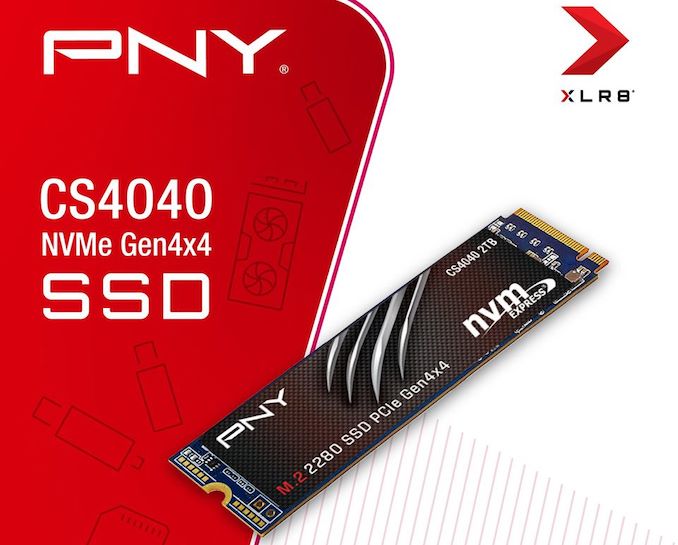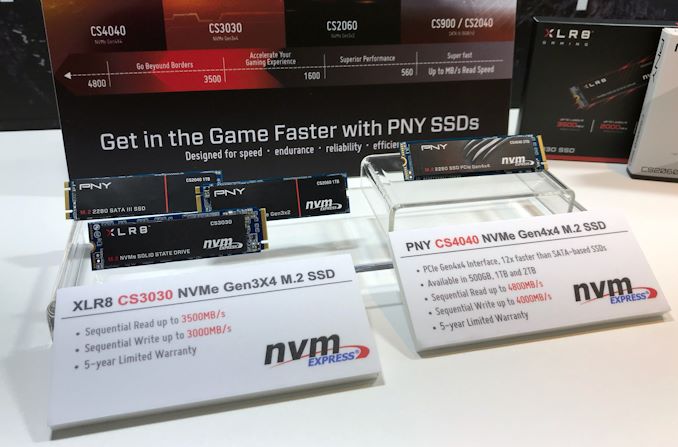PNY 2 TB XLR NVMe SSD: PCIe 4.0 x4, Up to 4.8 GB/s
by Anton Shilov on June 10, 2019 11:00 AM EST- Posted in
- SSDs
- Storage
- Trade Shows
- 3D NAND
- PNY
- 3D TLC
- PCIe 4.0
- Computex 2019
- PS5016-E16
- XLR8

Since many high-end SSDs these days are bottlenecked by a PCIe 3.0 x4 interface, next-generation drives featuring a PCIe 4.0 x4 connector were among the highlights of this year’s Computex. Being one of Phison’s well-known partners, PNY showcased its upcoming XLR8 CS4040 SSD with a PCIe 4.0 x4 interface at the trade show.
PNY’s high-end XLR8 CS4040 SSD is based on Phison’s turnkey PS5016-E16 platform with 3D TLC NAND and will be available in 500 GB, 1 TB, and 2 TB versions. At present, PNY expects the drive to offer up to 4800 MB/s sequential read speed as well as up to 4000 MB/s sequential write speed in case of 1 TB and 2 TB models as well as up to 2100 MB/s sequential write speed in case of 500 GB SKU.
Based on vague comments by the PNY rep we talked to about availability timeframe of the drive and knowing PNY’s inclination to firmware tweaking, we are not quite sure that the company will be the among the first to launch its PCIe 4.0 x4 SSD when the first PCIe 4.0 platforms hit the market this July. In fact, we would expect the company to take its time and do some tweaking.
At Computex, PNY demonstrated its XLR8 CS4040 SSD with a very simplistic sticker that can barely be an efficient heat spreader. As Phison’s PS5012-E12 and PS5016-E16 controllers have a TDP of up to 8 W, a proper heatsink might be needed to guarantee consistent performance. That said, we can only wonder whether PNY installs a heat spreader on its XLR8 CS4040 SSD to maximize performance under high loads, or goes with a sticker to maintain compatibility with existing and future notebooks.
Related Reading:
- More 2TB PCIe 4.0 SSD Options: Patriot with Custom Firmware coming Q4
- Galax Goes White: A PCIe 4.0 2TB SSD with a White PCB
- Essencore 2 TB PCIe 4.0 SSD Enters The Game
- GIGABYTE’s PCIe 4.0 SSD Uses 77g of Copper Due to 8W TDP, up to 2TB
- Phison’s PS5016-E16 & PS5019-E19: The First PCIe 4.0 Client SSD Controllers
- Corsair Announces MP600 NVMe SSD With PCIe 4.0
- GIGABYTE Teases PCIe 4.0 M.2 SSD in Press Release: 5 GB/s
| Want to keep up to date with all of our Computex 2019 Coverage? | ||||||
 Laptops |
 Hardware |
 Chips |
||||
| Follow AnandTech's breaking news here! | ||||||












21 Comments
View All Comments
AshlayW - Monday, June 10, 2019 - link
This could be the reason I maybe upgrade to X570. Part of me really wants three of the 1TB of these in RAID0. So I would have 3TB of ~10GB/s+ sequential read / write performance, assuming a bit of overhead. Basically RAMDISK performance (I always notice huge software/driver overheads with RAMDISK I use, I cannot actually get more than around 10GB/s even with 3200 MHz DDR4).It would be completely pointless, since my current Nvme gen3 4x is not actually bottlenecking me at all realistically, games dont really benefit from all this sequential performance but it's cool to have.
DanNeely - Monday, June 10, 2019 - link
At most I suspect you might notice a very slight improvement in loading and install times.PCIe3x4 vs SATA is noticable with my NVME work laptop is noticably faster in launching apps to the show on taskbar state when I do my post-login mass start than my SATA desktop at home despite the later having a faster clocked CPU. The difference is only a second or two, definitely not worth spending money on an upgrade at home for; but enough to be clearly seen. It's roughly app 1's icon popping while I'm clicking on app 2 vs app 3.
I noticed a much larger gain while installing stuff on the new laptop vs my old laptop (sata ssd); but since my old laptop had a much slower CPU and I haven't installed MS dev tools/databases on my home system I'm not sure how much of the difference there is IO and how much is elsewhere.
halcyon - Monday, June 10, 2019 - link
When you run complex web apps and all your browser, it's cache and it's profile all run from RamDisk, you will NEVER go back to running them from HD/SATA SSD. The difference can be big.Andy Chow - Monday, June 10, 2019 - link
There is no difference running web apps or browser, since all that data is in the RAM, using a RamDisk won't speed it up at all.deil - Monday, June 10, 2019 - link
not for gaming but at work I had to use 50 GB of data for some computing with this pull would finally be seconds... still 2 in any raid means all coworkers will hate you...DanNeely - Monday, June 10, 2019 - link
I wonder how long until we have controllers bottlenecked on the 4.0 interface.Ian Cutress - Monday, June 10, 2019 - link
The E16 controller is already the bottleneck. It's taking the PCIe 3.0 version and they've just swapped the PHYs. They're having to develop a new front end for the controllers in order to process data >5 GB/s. The NAND still has plenty of speed left.A5 - Monday, June 10, 2019 - link
Huh.I know the economics don't work out, but it would be interesting to see a modern SSD with fully-populated channels of lower-density NAND to cut size instead of just cutting channels.
DanNeely - Monday, June 10, 2019 - link
That was my point. The E16 isn't fast enough to be able to max out 4 4.0 lanes in sequential IO; which is my I'm wondering when the first controllers fast enough to fully utilize the bandwidth will be out.TheUnhandledException - Monday, June 10, 2019 - link
I would say at least a year. Companies are going to use existing controllers for this generation. They will want to recover R&D and design costs. The next gen drives in 2020 will be based on controllers which can saturate PCIe 4x4. Then the bottleneck moves back to the raw flash which will eventually get fast enough that drives all stall out at around 7 to 7.5 GB/s. Just in time for the whole cycle to repeat with PCIe 5.